Fancy Fiddles
For the ASO
By Carolyn Lee
You may have seen fish
out of water in Baltimore, or cows on parade in Chicago, even
embellished pigs in Seattle, but in Annapolis, you should be on
the lookout for painted violins. These fanciful works of art are
the products of the Painted Violins Project whose goal is to produce
visibility, publicity and financial support for the Annapolis
Symphony Orchestra.
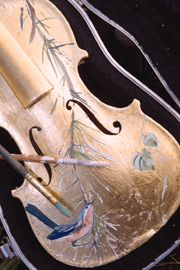 The funds raised from the raffle of these violins will benefit
the ASO and its education and outreach programs and the thousands
of children in our community each year by way of its Adopt-a-School
program, Music Van, Instrument Donation Drive, and Education and
Family concerts, all programs that have achieved national recognition.
The funds raised from the raffle of these violins will benefit
the ASO and its education and outreach programs and the thousands
of children in our community each year by way of its Adopt-a-School
program, Music Van, Instrument Donation Drive, and Education and
Family concerts, all programs that have achieved national recognition.
The violin project is the brainchild of the ASO's Pam Chaconas,who
took her cue from the success of a similar effort by the guild
of the Jacksonville Symphony Orchestra in Florida. "What we really
wanted to do was to find a way to give more attention to our programs
and develop new partnerships with local artists and galleries.
I think the artists are very in tune---no pun intended---with
this idea. They understand the importance of promoting the arts,
which are always in jeopardy and should be part of the core curriculum."
Using violins as their canvases, 10 local "artists of note" volunteered
to transform violins into unique works of art. The 10 violins
were actual instruments played by students and were donated by
the Music and Arts Center of Severna Park, a major sponsor of
the project. With help from volunteers, the Music and Arts Center
prepared the violins for the artists by sanding down the varnish
to the natural wood, and cleaning and removing strings and chin
rests from the instruments. The strings were replaced when the
artists finished painting the violins.
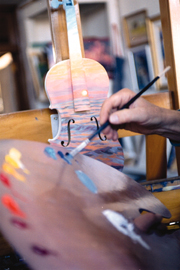 Says Music and Arts Center manager Shelly Mick, "It was hard to
visualize [the finished product] until [Pam] showed me the pictures
from the Jacksonville Symphony. I spent a good amount of time
getting the violins ready and really enjoyed it."
Says Music and Arts Center manager Shelly Mick, "It was hard to
visualize [the finished product] until [Pam] showed me the pictures
from the Jacksonville Symphony. I spent a good amount of time
getting the violins ready and really enjoyed it."
Bud Billups, chairman of the board of the ASO, admits to his own
lukewarm response to the idea at first. "Initially, I didn't have
a great deal of excitement about it. I didn't understand it very
well---it was foreign to me. But the more I learned, the more
exciting it sounded. I think it's a fun project for a lot of people."
The artists themselves, of course, had a variety of responses
to the idea of using a violin as their canvas. Elizabeth Dax of
Niermann Weeks, a company which specializes in heavily antiqued
custom painted furniture,was not unfamiliar with the technique
of painting on wood. "I looked at the [violin's] shape and curves
and wanted to make it look like a well-worn, much-cherished little
gem," says Dax. "I used these whimsical Italian motifs and subdued
my colors and put lots of glazes on and aged it a lotto look very
rich, very Italian, very old."
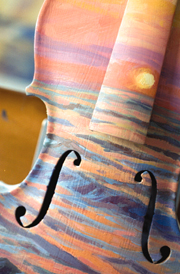 In contrast, Joanette Egeli, a child's portrait painter accustomed
to oil on canvas---and opposed to using acrylics, had technical
concerns about the permanence of oil paint applied to the acidic
qualities of the natural wood. The quality and excellence of the
finished piece were important to her.
In contrast, Joanette Egeli, a child's portrait painter accustomed
to oil on canvas---and opposed to using acrylics, had technical
concerns about the permanence of oil paint applied to the acidic
qualities of the natural wood. The quality and excellence of the
finished piece were important to her.
Artist Nancy Hammond, whose favorite medium is colored cut paper,
recalls thinking, "What will the violinist think? I had just heard
a radio program where they interviewed a wonderful violinist.
He just couldn't stand to see the abstraction of the violin in
any form and feared that artists tortured the instruments. I knew
then that what I did would be incredibly respectful."
Watercolorist Pat McHold, however, sees the language of the visual
and performing arts as interchangeable. "When I'm painting or
doing any sculpture, I think about rhythm and tempo and spaces,
about what the loud sounds and quiet sounds are and what is emphasized
and what isn't."
For Myra Copus,who has developed a unique watercolor technique,
the idea became even more interesting when the violin was delivered.
"I could picture it in a more tactile way. I was painting Christmas
balls at the time and the first thing I thought of was the Nutcracker.
I was thinking Old World, Mozart, Salzburg, old Russian boxes---creating
that kind of beauty."
Phyllis Avedon, whose major focus is portraiture, lived in the
tropics for 13 years. She used the vivid colors of tropical flowers
as her inspiration to create a differet kind of beauty.
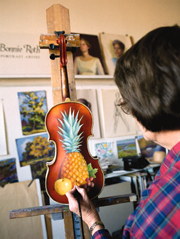 Bonnie Roth Anderson usually works in oils and pastels for her
commissioned portraits. She recalls, "We (at Maryland Hall) were
very excited when we heard about it---it's so different from what
we usually do. My first thought was that this is going to be so
much fun, and I had an idea right on the spot! I always say that
artists have more fun than anyone else---this is true for musicians
as well. Isn't it nice that we can collaborate?"
Bonnie Roth Anderson usually works in oils and pastels for her
commissioned portraits. She recalls, "We (at Maryland Hall) were
very excited when we heard about it---it's so different from what
we usually do. My first thought was that this is going to be so
much fun, and I had an idea right on the spot! I always say that
artists have more fun than anyone else---this is true for musicians
as well. Isn't it nice that we can collaborate?"
Oil painter John Ebersberger eased the transition from canvas
to violin by fitting his turn-of-the-century design to the actual
shape of the violin. "The neck of the violin comes down so far
into the face that it's like having a canvas with a big black
line [bisecting it]." By incorporating the violin's s-curves and
f-holes, he dovetailed his design with the instrument's sensual
shape.
Gerry Valerio, long-time book designer now painting full time,
has worked closely with the ASO over the years, creating educational
brochures, posters and seasonal publications. When asked if he
thought the idea would work, he replied, "I had a pretty good
idea that the painters would be enthusiastic about the project,
although it would be an enormous challenge." Gerry spoke of the
transition from a two-dimensional canvas to the three-dimensional
violin. "What I found interesting is that you have to change your
normal concept of the surface to adapt to the limitations of the
instrument-the scale, the shape [of the violin] as a human torso."
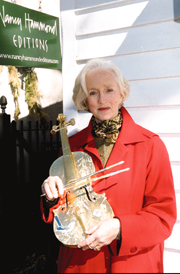 Lee Boynton, artist-in-residence at Maryland Hall for 22 years,
also had a long-standing relationship with many in the Annapolis
Symphony Orchestra---musicians, conductors, board members. "They
all supported me in the past and this was a wonderful opportunity
to pay them back." The symphony is an important focusing element
at Maryland Hall. People who come to the performances also visit
the galleries---this is how Maryland Hall was orginally conceived.
Lee travels all over the country doing workshops and observes
that Maryland Hall is the only venue which houses the visual and
performing arts under one roof. "We have the unusual and unique
opportunity to network and work together in projects just like
this." And, he adds, "I have been in my studio many times when
the symphomy is rehearsing. I open my door and marvel at the luxury
I have."
Lee Boynton, artist-in-residence at Maryland Hall for 22 years,
also had a long-standing relationship with many in the Annapolis
Symphony Orchestra---musicians, conductors, board members. "They
all supported me in the past and this was a wonderful opportunity
to pay them back." The symphony is an important focusing element
at Maryland Hall. People who come to the performances also visit
the galleries---this is how Maryland Hall was orginally conceived.
Lee travels all over the country doing workshops and observes
that Maryland Hall is the only venue which houses the visual and
performing arts under one roof. "We have the unusual and unique
opportunity to network and work together in projects just like
this." And, he adds, "I have been in my studio many times when
the symphomy is rehearsing. I open my door and marvel at the luxury
I have."
The violins are exhibited in various venues for several months.
Raffle tickets are available at most of the exhibit sites and
through the ASO office. The violins can be seen at Maryland Hall
during ASO concerts, at the ASO's major donor party and at a variety
of receptions, galleries, bookstores and other retail establishments
throughout Annapolis. The violins will travel to Quiet Waters
Park in April as part of the reception for the student art exhibit
and to Anne Arundel Community College in May. They will also make
their way to the new Chesapeake Center for the Creative Arts in
Brooklyn Park and to the Rural Heritage Society at the Captain
Salem Avery House in Shady Side. "I thought it was really important
that we bring the violins as far north and south in Anne Arundel
County as possible," says Pam Chaconas.
 "Do you want to see one?" she says, anxious to show off one of
the "beautiful musical masterpieces" she envisioned. She disappeared,
then reappeared with violin in hand---transformed into a beautiful
and unique work of art.There is something so fundamentally appealing
about the shape of a violin and all the pleasure its music brings
that it's not difficult to understand why this unusual idea has
been so successful. It looks like everyone involved in this project
has had a lot of fun and that the ASO's education and outreach
program has truly found a new
way to excite the imagination of all generations.
"Do you want to see one?" she says, anxious to show off one of
the "beautiful musical masterpieces" she envisioned. She disappeared,
then reappeared with violin in hand---transformed into a beautiful
and unique work of art.There is something so fundamentally appealing
about the shape of a violin and all the pleasure its music brings
that it's not difficult to understand why this unusual idea has
been so successful. It looks like everyone involved in this project
has had a lot of fun and that the ASO's education and outreach
program has truly found a new
way to excite the imagination of all generations.
Back
|

